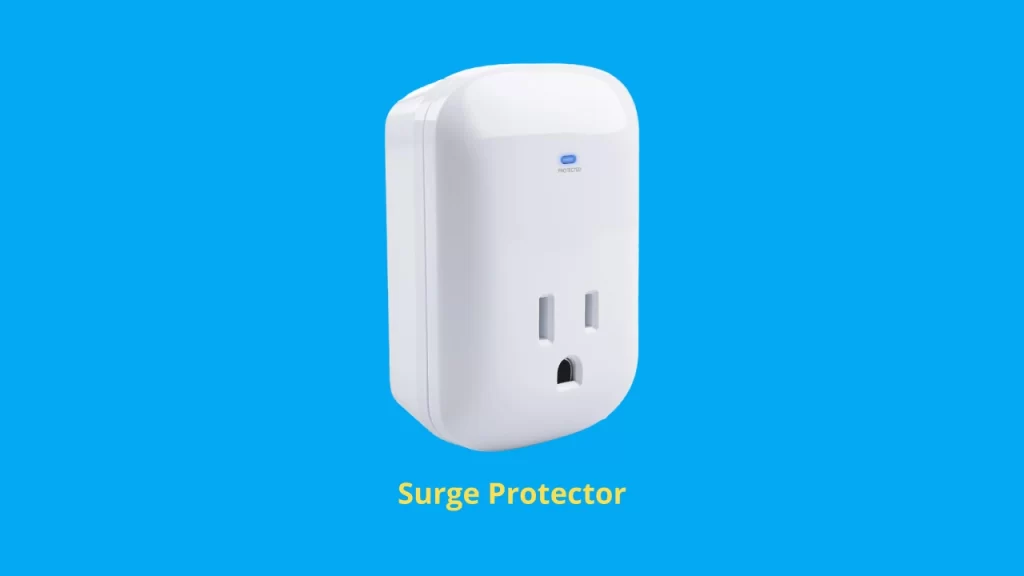Generally, a smart TV needs a surge protector since the power surge can easily damage the sensitive electronic circuits of a television. With an inexpensive surge protector, you can enjoy peace of mind and safeguard your television and other expensive electronic devices.
The term “power surge” sounds like trouble, even if you can’t quite grasp its meaning. When you throw your expensive smart TV into the same sentence, you’ll end up with a nagging question that can keep you up at night.

As per copper.org data on power surges, I found that most homes experience an average of six power surges per day which comes to around 2000 power surges a year.
If your home electronic devices are not protected from these power surges, these spikes will damage sensitive electronic circuits used in televisions, computers, telephones, and other home entertainment equipment.
In this article, we dive deeper into what surge protectors do, why you should buy one for your precious TV and more!
Why Your Smart TV Needs a Surge Protector?

Before we discuss why a surge protector is a must for your TV, let’s quickly go over how it works.
As the name suggests, this nifty piece of equipment absorbs excess voltage that may result from a power surge. After that, it directs this extra power toward the ground wire so that it doesn’t hit your electronic devices.
Remember that power surges happen often, and not just when the electricity comes back on after going out. A power surge accompanies several scenarios, including:
- A blown transformer
- Air conditioner or refrigerator motor pausing or working again
- Lighting strikes on utility equipment
But what happens if you leave your smart TV unprotected in the face of a power surge?
Well, if you couldn’t unplug your TV before a power surge (and it’s not always predictable), the odds may not be in your favor. The fluctuation in voltage from a power surge can seriously harm the microprocessor in your TV if it’s a strong one.
Even small power surges could negatively affect the sensitive internal parts of the TV over time.
Your TV won’t stop working straight out, of course, but it might develop electronic rust. As a result, its performance will go down more rapidly, shortening the lifespan of your pricey TV.
Experts even claim that allowing your devices to face multiple power surges might lead to losing your data. No one wants to deal with such an annoying situation!
Sometimes you may have to use a voltage stabilizer, so check our guide on Do Smart TVs Need Stabilizer?
The 3 Best Surge Protectors for Your Smart TV
Now that you understand how crucial it is to invest in a reliable surge protector, let’s walk you through the top three market options to pick from!
1. Cable Matters Surge Protector for TV
This ETL-listed single-plug surge protector can be the perfect addition to your TV setup if you’re looking for a basic option.
Don’t have several devices to plug into a surge protector? Order this Cable Matters product and enjoy its impressive features. These aspects include a 900V L-N VPR rating to boost protection and an LED to show you surge protection status.
It’s also available in a wall outlet design for hassle-free installation without having to deal with a bunch of tangled cords!
2. SUPERDANNY Surge Protector
For those who need a multi-purpose and versatile surge protector to cater to their different uses, this SUPERDANNY product can be just right.
It gives you more liberty to plug in other devices besides your TV screen, such as a gaming console, sound system, PC, lighting units, etc. This way, you can have all your power cords in one place, protected by one heavy-duty extension cord.
This is all thanks to its 22 AC outlets as well as six USB charging ports. As a result of its many power outlets, it can be ideal for a dorm room, office, family room, and other spaces that require functionality and convenience.
Last but not least, you’ll love that this surge protector/extension cord comes in 6.5, 8, 10, and 15-foot versions.
3. Nuetsa Flat Plug Extension Cord and Surge Protector
Our final recommendation is the Nuetsa surge protector for people who want a middle ground between the previous two products.
It features eight AC outlets and four USB charging ports that include a USB-C option and smart charge support. Not just that, you may also use it on 120v to 240v circuits!
Lastly, this highly-rated power strip boasts a minimum 2700 joules absorbing capacity. In other words, it is one of the most reliable surge protectors on the market.
How Long Is a Surge Protector Good for When Used With a TV?
The thing about surge protectors is that they get worn down the more power surges that they deal with. The more joules they endure, the fewer future joules they can divert away from your TV.
For this reason, it’s best to replace your TV surge protector every three years.
Thankfully, many protectors on the market come with an LED that gives you an idea about the joules of protection available. So, monitor this indicator to know when to replace your device.
What Are Other Electronic Devices That Need a Surge Protector?
Smart TVs aren’t the only electronic devices you must pair with a solid surge protector to prevent their circuits from being fried after a power surge!
As a general rule, all appliances and devices with microprocessors are susceptible to damage due to power surges.
This is why it’s a good idea to plug the following devices into surge protectors, too, to increase their lifespans:
- PCs and laptops
- Phone chargers
- Routers
- Gaming setups and systems
- Medical equipment
- Any smart or computerized devices within your household
Which Devices Don’t Need Surge Protectors?
Most devices that don’t feature a sensitive microprocessor within their systems can do fine without a surge protector. For example, alarm clocks, coffee pots, vacuum cleaners, and the like fall into this category.
More interestingly, others with high power capacity are a big no-no, like microwaves and space heaters. You must plug these devices right into the wall outlet.
How Many Volts Are There in a Typical Power Surge?
Typically, there is around 169 volts in a residential power surge, for a commercial system it can be around 1,000+ volts.
For example, in in North America power outlets have 120 volts circuits.
Frequently Asked Questions
What should I do if I experience a power surge despite having a surge protector for my TV?
If you experience a power surge despite having a surge protector for your TV, you should unplug the TV and the surge protector from the wall and then plug them back in. This will reset the surge protector and hopefully solve the issue.
What are the signs that my surge protector needs to be replaced?
The signs that your surge protector needs to be replaced include the indicator light not working, the protector not providing power to your devices, or physical damage to the device.
What are some other factors to consider when buying a surge protector for my electronic devices besides joule rating?
Some other factors to consider when buying a surge protector for your electronic devices besides joule rating are number of outlets, cord length, and warranty.
Conclusion
So, does your smart TV need a surge protector after all?
After reading this article, now you know it’s better to pair your TV with a sturdy surge protector to prevent damage to its internal parts. This way, you can stop worrying about spikes and power surges for the time being!

